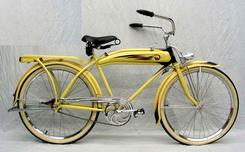


During the summer of 1819 the "hobby-horse", thanks in part to Johnson's marketing skills and better patent protection, became the craze and fashion in London society. Johnson's machine was an improvement on Drais's, being notably more elegant: his wooden frame had a serpentine shape instead of Drais's straight one, which allowed the use of larger wheels without raising the seat higher. We can assume a name change occurred when Johnson patented his vehicle and named it “pedestrian curricle” or “velocipede,” but the public preferred nick-names like “hobbyhorse,” after the children’s toy or, worse still, “dandyhorse,” after the foppish men who often rode them. Shortly after, the concept was picked up by a number of British cartwrights the most notable being Denis Johnson of London. Eesfehani, Amir Moghaddaas: "The Bicycle's Long Way to China", "Cycle History" 13, San Francisco 2003, pp. However in 1866 Paris a Chinese visitor named Bin Chun could still observe foot-pushed velocipedes. Its popularity rapidly faded when, partly due to increasing numbers of accidents some city authorities began to prohibit its use. This design was welcomed by mechanically minded men daring to balance and several thousand copies were built and used, primarily in Western Europe and in North America. "LODA, eine neuerfundene Fahrmaschine" in: "Badwochenblatt für die Großherzogliche Stadt Baden" of 29th of July 1817] The wooden draisine weighed 22 kg (48 pounds), had brass bushings within the wheel bearings, a rear-wheel brake and 152 mm (6 inches) of trail of the front-wheel for a self-centering castor effect. 28-36 ] On his first reported ride from Mannheim on June 12, 1817, he covered 13 km (eight miles) in less than an hour. cite web|url=|title=Lessing, Hans-Erhard: "What Led to the Invention of the Early Bicycle?" "Cycle History" 11, San Francisco 2001, pp. Hans-Erhard Lessing found from circumstantial evidence that Drais' interest in finding an alternative to the horse was the starvation and death of horses caused by crop failure in 1816 (" eighteen hundred and froze to death," following the volcanic eruption of Tambora). It was constructed almost entirely of wood. It was initially manufactured in Germany and France. Karl von Drais patented this design in 1818 which was the first commercially successful two-wheeled, steerable, human-propelled machine commonly called a velocipede, nick-named hobby-horse or dandy horse. Drais invented his Laufmaschine ( German for "running machine") of 1817 that was called "Draisine" (English) or "draisienne" (French) by the press. The first reliable claim for a practically-used bicycle belongs to German Baron Karl von Drais, a civil servant to the Grand Duke of Baden in Germany. Augusto Marinoni, a lexicographer, who was entrusted by the Commissione Vinciana of Rome with the transcription of da Vinci's Codex Atlanticus. 49-56] However, the authenticity of the bicycle sketch is still vigorously maintained by the Italian cultural bureaucracy still believing the misled Prof. Lessing, Hans-Erhard: "The evidence against Leonardo's bicycle", "Cycle History" 8, San Francisco 1998, pp. Hans-Erhard Lessing recently showed this last assertion to be a purposeful fraud. La véritable histoire du vélo." Éditions du Rouergue 1988, 13-17] An earlier English version appeared as "The End of De Sivrac" in "The Boneshaker" #85(1977)]Įarlier, and equally unreliable, claims come from an illustration found in a church window in Stoke Poges, installed in the 16th century, showing an angel on a bicycle-like device, Whitt, Frank R: "What is that Cherub doing?" "Cycletouring" (1971)] and from a scribble said to be from 1493 and attributed to Gian Giacomo Caprotti, a pupil of Leonardo da Vinci. We now know that a two-wheeled célérifère never existed besides the four-wheeled ones and that it was a misinterpretation by the well known French journalist Louis Baudry de Saunier in 1891. Pages = 4-8] A rider was said to have to sat astride the machine and pushed it along using alternate feet. Title = Histoire Générale de la Vélocipédie The célérifère supposedly had two wheels set on a rigid wooden frame and no steering, directional control being limited to that attainable by leaning. There are several early but unreliable claims for the invention of bicycle-like machines.Ī Comte de Sivrac was said to have developed a two-wheeler called a célérifère in 1791, demonstrating it at the Palais-Royal in France. The term " bicycle" was coined in France in the 1860s. The first means of transport making use of two wheels, and thus the archetype of the bicycle, was the German " draisine" dating back to 1817.

Vehicles for human transport that have two wheels and require balancing by the rider date back to the early 19th century.


 0 kommentar(er)
0 kommentar(er)
